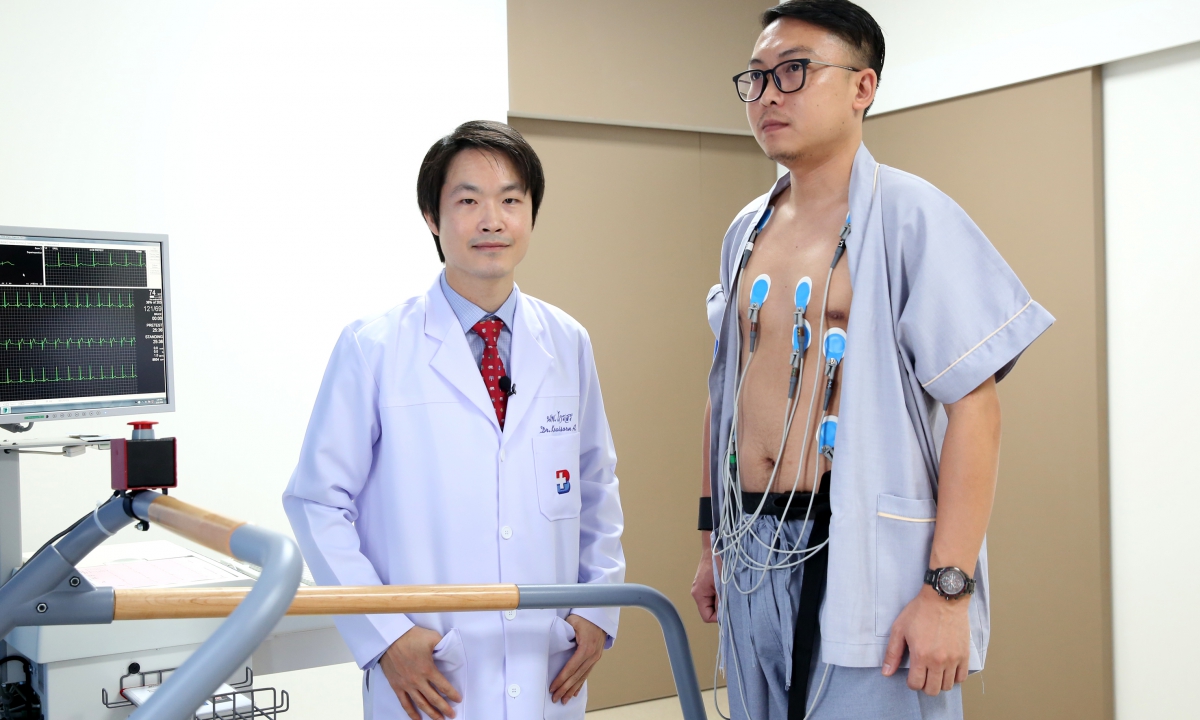
Specialized cardiac tests are very useful in both diagnosing and assessing the severity of heart disease. After the doctor has taken your medical history, completed a physical examination, and ordered preliminary tests, such as blood tests, electrocardiogram, or chest X-ray, specialized cardiac tests can be completed. Commonly used tests include exercise stress tests, echocardiograms, CT scans, and coronary angiograms.
Exercise stress test
An exercise stress test, sometimes called a treadmill test, can be used to help diagnose coronary artery disease in patients who have symptoms such as chest pain, shortness of breath, or fatigue when exercising. The test can be also performed in those who don’t exhibit symptoms but are at high risk of cardiovascular disease. An exercise stress test can even be used to evaluate the performance of the heart, lungs, and muscle. It might be recommended to help determine the timing for cardiac surgery or to determine your level of health before a sporting event or starting a new exercise program.
In an exercise stress test, walking or running is used to stimulate the heart to work harder while symptoms and an electrocardiogram (ECG) are monitored to look for abnormalities. During the test, the patient will walk or run on a treadmill to speed up the heart rate until it reaches a set target, which usually takes 6-12 minutes. The doctor will then interpret the results based on the symptoms experienced during the test combined with the analysis of ECG results. However, this test can only indirectly diagnose coronary artery disease, since it doesn’t directly measure whether coronary arteries are narrowed or not. This test has an accuracy in correctly diagnosing coronary artery disease of about 70-80%. But because it is an easy method, it is suitable as an initial screening tool. In cases where the examination results are unclear, or patients are unable to run on a treadmill due to physical limitations, the doctor will recommend additional tests instead.
Echocardiogram
An echocardiogram test uses ultrasound waves to produce a live image of the heart, allowing a doctor to evaluate the shape and functioning of the heart. The test is able to measure the size and thickness of heart chambers, how valves in the heart are functioning, and the direction of blood flow through the heart. It is a very useful tool used in diagnosing and assessing the severity of several types of heart disease, including weak pumping or stiffening of the heart muscle, leaky or blocked heart valves, and chamber enlargement, and can even be used in assessing coronary artery disease. This test may be recommended for patients with symptoms related to heart disease, including chest pain, shortness of breath, swelling, fainting, or irregular heartbeat. The test may even be recommended for hypertensive patients who do not have any heart disease symptoms, since it can detect heart muscle thickening caused by high blood pressure.
This test can only indirectly diagnose coronary artery disease, since it cannot be used to directly observe coronary arteries. Rather, it can be used to indirectly diagnose coronary artery disease based on the functioning of the heart muscle. In patients with severe cardiovascular disease and ischemic heart disease or in patients who have previously had a myocardial infarction (heart attack), an echocardiogram will detect abnormal heart muscle functions. Also, echocardiogram is very useful in diagnosis and assessment in severity for those who have cardiomyopathy, thinning of the heart muscle wall, or an enlarged heart. During the test, the patient is placed on their left side with their chest exposed, and the ultrasound probe is maneuvered around the chest area. The test does not take long, and the results can be reported immediately.
CT scan
A computerized tomography (CT) scan uses computers and rotating X-ray machines to create cross-sectional images. It can see the structure of the whole heart and can also assess coronary artery calcium (CAC), which helps predict the likelihood of cardiovascular disease. A heart CT scan may also be called a coronary CT angiogram if a specialized dye is injected into your bloodstream during the test. The dye is then viewed using a special camera to view the arteries that bring blood to your heart, which can assess whether the coronary artery is narrowed or not. Hence, it is very useful in the diagnosis of coronary heart disease. CT scans are highly accurate in their diagnosis. As such, it is suitable for the detection of cardiovascular disease in patients both with symptoms and without symptoms but at high risk, as well as for use in patients who cannot perform an exercise stress test or in following up on inconclusive results from other tests.
Coronary Angiogram
In this test, a thin hollow tube called a catheter is passed through an artery and carefully up into the heart. Once the catheter is in place, a special dye is injected into the catheter, which can be observed using X-rays. It is the most accurate diagnostic test and considered the gold standard for the diagnosis of coronary artery disease. Coronary angiograms are part of a general group of procedures known as heart (cardiac) catheterizations. Cardiac catheterization procedures can both diagnose and treat heart and blood vessel conditions at the same time.
A coronary angiogram is recommended for people who have a high likelihood of coronary artery disease or as a follow up to inconclusive results from other tests. It is also used in emergency cases where a patient has acute myocardial infarction (heart attack). As this procedure is performed through a catheter, only a small incision is made near the groin or wrist for inserting the catheter. Therefore, it can be performed under local anesthesia, requiring only a short recovery period. In cases where the catheter is inserted through the wrist, the patient will be able to sit up or walk shortly after the procedure.